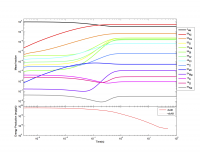EXERCISES
Reaction Networks, Nucl Physics Input, Hydro, BBN
(During-Course Assignment)
- Make sure everyone got the pre-test done and correct.
- Re-run the pre-test, reducing the temperature in the thermodynamic file
- Find the minimum temperatures at which silicon burning, oxygen burning and carbon burning occur.
- Grab a new (larger, 150 species) sunet_sn150.txt from the document server.
- Rename sunet_150.txt to sunet
- Build a new Data directory from REACLIB
- Create a new initial abundance file (matching the composition in the pretest)
- Run same test problem with new network
- Compare results to pre-test.
- Compare timing of pre-test to new problem.
Additional possibilities:
Run a reaction network with given nuclear input for:
- Fixed temperature and density
- Try various temperatures and densities
- Try different network sizes
- Swap out a reaction rate with a different version
- Vary initial composition (X, Y, Z or Ye)
- Let evolve until Nuclear Statistical Equilibrium is reached
- Temperature/density trajectories
- $ T(t) = T(0)\exp{(-t/\tau)} $ or $\ T(t) = T(0)(1+\frac{t}{n\tau})^{-n} $
- $ [1.+f_{\nu}(T(0))]\rho (t) = \rho (0) [1.+f_{\nu}(T(t))](T(t)/T(0))^3$
- How do initial conditions affect the resulting nucleosynthesis
- How does the trajectory form affect the results?
(Pre-Course Assignment)
Download, compile and run the Reaction Network Code
- Download the Reaction Network Code.
- Compile the code with your fortran90 compiler, following the instructions in doc/Compiling.txt in the XNet distribution.
- Report in the Reaction Network Code discussion thread your success with machine and compiler information.
- Run a first test problem, following the instructions in doc/Running.txt in the XNet distribution.
- Try various temperatures and densities by changing the th_const file.
